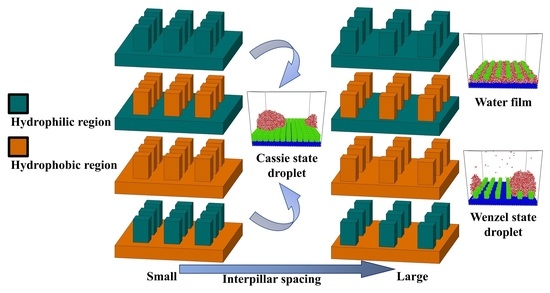Design of Nanostructured Surfaces for Efficient Condensation by Controlling Condensation Modes
Abstract
1. Introduction
2. Models and Methods
3. Results and Discussions
3.1. Condensation on Nanopillar Surfaces
3.1.1. Condensation Process of Three Typical Condensation Modes
3.1.2. Condensation on the Nanopillar Surfaces with Uniform Wettability
3.1.3. Condensation on the Nanopillar Surfaces with Hybrid Wettability
3.2. Effect of Nanopillar Surface Parameters on Condensation Rate
3.2.1. Interpillar Spacing
3.2.2. Surface Wettability Distribution
3.3. Dewetting-Like Behavior during Condensation
3.4. Condensation on the Hydrophobic Nanopillar Surfaces with Hydrophilic Tops
4. Conclusions
- Three typical condensation modes are observed on nanopillar surfaces, namely Cassie-Baxter DWC mode, Wenzel DWC mode, and FWC mode, respectively.
- The condensation mode is primarily determined by the nanopillar wettability when the nanopillars are densely distributed, while the substrate wettability mainly affects the condensation mode when the nanopillars are sparsely distributed.
- The effective contact area fraction is proposed, which more accurately reflects the influence of geometric parameters on the condensation rate of the nanopillar surface at the nanoscale compared to the surface solid fraction. Specifically, the condensation rate of the nanopillar surface increases with the increase of the effective contact area fraction.
- The effect of wettability distribution on condensation rate differs for nanopillar surfaces with different geometric parameters.
- For efficient condensation, three surface design methods are summarized, which can control the condensation mode of water vapor on the surface into the dropwise condensation mode that generates Cassie-Baxter droplets. Specifically, the design guidelines are smaller nanostructure spacing, lower surface energy, and suitable surface wettability distribution (such as hydrophobic nanopillar surfaces with hydrophilic tops), respectively.
Supplementary Materials
Author Contributions
Funding
Data Availability Statement
Acknowledgments
Conflicts of Interest
References
- Winkler, P.M.; Aron, V.; Wagner, P.E.; Markku, K.; Lehtinen, K.E.J.; Timo, V. Mass and thermal accommodation during gas-liquid condensation of water. Phys. Rev. Lett. 2004, 93, 075701. [Google Scholar] [CrossRef]
- Mekonnen, M.M.; Hoekstra, A.Y. Four billion people facing severe water scarcity. Sci. Adv. 2016, 2, e1500323. [Google Scholar] [CrossRef]
- Wang, F.; Liang, C.-H.; Yang, M.-T.; Zhang, X.-S. Preliminary study of a novel defrosting method for air source heat pumps based on superhydrophobic fin. Appl. Therm. Eng. 2015, 90, 136–144. [Google Scholar] [CrossRef]
- Park, K.-C.; Chhatre, S.S.; Srinivasan, S.; Cohen, R.E.; McKinley, G.H. Optimal Design of Permeable Fiber Network Structures for Fog Harvesting. Langmuir 2013, 29, 13269–13277. [Google Scholar] [CrossRef]
- Miljkovic, N.; Wang, E.N. Condensation heat transfer on superhydrophobic surfaces. MRS Bull. 2013, 38, 397–406. [Google Scholar] [CrossRef]
- Khawaji, A.D.; Kutubkhanah, I.K.; Wie, J.M. Advances in seawater desalination technologies. Desalination 2008, 221, 47–69. [Google Scholar] [CrossRef]
- Varanasi, K.K.; Deng, T.; Smith, J.D.; Hsu, M.; Bhate, N. Frost formation and ice adhesion on superhydrophobic surfaces. Appl. Phys. Lett. 2010, 97, 234102. [Google Scholar] [CrossRef]
- Wang, H.S.; Rose, J.W. A Theory of Film Condensation in Horizontal Noncircular Section Microchannels. J. Heat Transf. 2005, 127, 1096–1105. [Google Scholar] [CrossRef]
- Rose, J.W. Dropwise condensation theory and experiment: A review. Proc. Inst. Mech. Eng. Part A J. Power Energy 2002, 216, 115–128. [Google Scholar] [CrossRef]
- Su, J.; Charmchi, M.; Sun, H. A Study of Drop-Microstructured Surface Interactions during Dropwise Condensation with Quartz Crystal Microbalance. Sci. Rep. 2016, 6, 35132. [Google Scholar] [CrossRef]
- Mandsberg, N.K. Spatial Control of Condensation: The Past, the Present, and the Future. Adv. Mater. Interfaces 2021, 8, 2100815. [Google Scholar] [CrossRef]
- Liu, M.; Wang, S.; Jiang, L. Nature-inspired superwettability systems. Nat. Rev. Mater. 2017, 2, 17036. [Google Scholar] [CrossRef]
- Tang, Y.; Yang, X.; Li, Y.; Lu, Y.; Zhu, D. Robust Micro-Nanostructured Superhydrophobic Surfaces for Long-Term Dropwise Condensation. Nano Lett. 2021, 21, 9824–9833. [Google Scholar] [CrossRef] [PubMed]
- Zhu, H.; Cai, S.; Liao, G.; Gao, Z.F.; Min, X.; Huang, Y.; Jin, S.; Xia, F. Recent Advances in Photocatalysis Based on Bioinspired Superwettabilities. ACS Catal. 2021, 11, 14751–14771. [Google Scholar] [CrossRef]
- Zheng, Y.; Han, D.; Zhai, J.; Jiang, L. In situ investigation on dynamic suspending of microdroplet on lotus leaf and gradient of wettable micro- and nanostructure from water condensation. Appl. Phys. Lett. 2008, 92, 084106. [Google Scholar] [CrossRef]
- Feng, L.; Zhang, Y.; Xi, J.; Zhu, Y.; Wang, N.; Xia, F.; Jiang, L. Petal Effect: A Superhydrophobic State with High Adhesive Force. Langmuir 2008, 24, 4114–4119. [Google Scholar] [CrossRef]
- Gao, X.; Yan, X.; Yao, X.; Xu, L.; Zhang, K.; Zhang, J.; Yang, B.; Jiang, L. The Dry-Style Antifogging Properties of Mosquito Compound Eyes and Artificial Analogues Prepared by Soft Lithography. Adv. Mater. 2007, 19, 2213–2217. [Google Scholar] [CrossRef]
- Parker, A.R.; Lawrence, C.R. Water capture by a desert beetle. Nature 2001, 414, 33–34. [Google Scholar] [CrossRef]
- Wigzell, J.M.; Racovita, R.C.; Stentiford, B.G.; Wilson, M.; Harris, M.T.; Fletcher, I.W.; Mosquin, D.P.K.; Justice, D.; Beaumont, S.K.; Jetter, R.; et al. Smart water channelling through dual wettability by leaves of the bamboo Phyllostachys aurea. Colloids Surf. Physicochem. Eng. Aspects 2016, 506, 344–355. [Google Scholar] [CrossRef]
- Park, K.-C.; Kim, P.; Grinthal, A.; He, N.; Fox, D.; Weaver, J.C.; Aizenberg, J. Condensation on slippery asymmetric bumps. Nature 2016, 531, 78–82. [Google Scholar] [CrossRef]
- Sharma, C.S.; Combe, J.; Giger, M.; Emmerich, T.; Poulikakos, D. Growth Rates and Spontaneous Navigation of Condensate Droplets Through Randomly Structured Textures. ACS Nano 2017, 11, 1673–1682. [Google Scholar] [CrossRef] [PubMed]
- Fu, X.; Zhu, Q.; Liu, D.; Liu, B.; Kuang, L.; Feng, Y.; Chu, F.; Huang, Z. Enhanced Moisture Condensation on Hierarchical Structured Superhydrophobic–Hydrophilic Patterned Surfaces. Langmuir 2022, 38, 863–869. [Google Scholar] [CrossRef] [PubMed]
- Monga, D.; Guo, Z.; Shan, L.; Taba, S.A.; Sarma, J.; Dai, X. Quasi-Liquid Surfaces for Sustainable High-Performance Steam Condensation. ACS Appl. Mater. Interfaces 2022, 14, 13932–13941. [Google Scholar] [CrossRef] [PubMed]
- Enright, R.; Miljkovic, N.; Al-Obeidi, A.; Thompson, C.V.; Wang, E.N. Condensation on Superhydrophobic Surfaces: The Role of Local Energy Barriers and Structure Length Scale. Langmuir 2012, 28, 14424–14432. [Google Scholar] [CrossRef] [PubMed]
- Hou, Y.; Yu, M.; Chen, X.; Wang, Z.; Yao, S. Recurrent Filmwise and Dropwise Condensation on a Beetle Mimetic Surface. ACS Nano 2015, 9, 71–81. [Google Scholar] [CrossRef] [PubMed]
- Chehrghani, M.M.; Abbasiasl, T.; Sadaghiani, A.K.; Koşar, A. Biphilic Surfaces with Optimum Hydrophobic Islands on a Superhydrophobic Background for Dropwise Flow Condensation. Langmuir 2021, 37, 13567–13575. [Google Scholar] [CrossRef] [PubMed]
- Boreyko, J.B.; Hansen, R.R.; Murphy, K.R.; Nath, S.; Retterer, S.T.; Collier, C.P. Controlling condensation and frost growth with chemical micropatterns. Sci. Rep. 2016, 6, 19131. [Google Scholar] [CrossRef] [PubMed]
- Gong, X.; Gao, X.; Jiang, L. Recent Progress in Bionic Condensate Microdrop Self-Propelling Surfaces. Adv. Mater. 2017, 29, 1703002. [Google Scholar] [CrossRef]
- Wang, Q.; Xie, H.; Liu, J.; Liu, C. Heterogeneous nucleation of argon vapor on the nanostructure surface with molecular dynamics simulation. J. Mol. Graph. Model. 2020, 100, 107674. [Google Scholar] [CrossRef]
- Ding, W.; Han, D.; Zhang, J.; Ma, Q.; Li, X.; Zhang, J.; Wang, X. Molecular dynamics study of anisotropic behaviours of water droplet on textured surfaces with various energies. Mol. Phys. 2021, 119, e1785028. [Google Scholar] [CrossRef]
- Ghahremanian, S.; Abbassi, A.; Mansoori, Z.; Toghraie, D. Effect of nanostructured surface configuration on the interface properties and heat transfer of condensation process of argon inside nanochannels using molecular dynamics simulation. J. Mol. Liq. 2021, 339, 117281. [Google Scholar] [CrossRef]
- Paul, S.; Hasan, M.N. Molecular dynamics perspective of condensation over a hybrid wetting surface. Mol. Simul. 2022, 48, 448–461. [Google Scholar] [CrossRef]
- Sheng, Q.; Sun, J.; Wang, Q.; Wang, W.; Wang, H.S. On the onset of surface condensation: Formation and transition mechanisms of condensation mode. Sci. Rep. 2016, 6, 30764. [Google Scholar] [CrossRef] [PubMed]
- Che, Q.; Lu, Y.; Wang, F.; Zhao, X. Effect of substrate wettability and flexibility on the initial stage of water vapor condensation. Soft Matter 2019, 15, 10055–10064. [Google Scholar] [CrossRef] [PubMed]
- Hiratsuka, M.; Emoto, M.; Konno, A.; Ito, S. Molecular Dynamics Simulation of the Influence of Nanoscale Structure on Water Wetting and Condensation. Micromachines 2019, 10, 587. [Google Scholar] [CrossRef]
- Gao, S.; Liu, W.; Liu, Z. Tuning nanostructured surfaces with hybrid wettability areas to enhance condensation. Nanoscale 2019, 11, 459–466. [Google Scholar] [CrossRef]
- Ding, W.; Wang, M.; Dai, X.; Zhang, J.; Xin, G.; Wang, X. Dewetting transition of water on nanostructured and wettability patterned surfaces: A molecular dynamics study. J. Mol. Liq. 2021, 336, 116869. [Google Scholar] [CrossRef]
- Che, Q.; Yang, S.; Wang, F. Effect of channel wettability on the single-file water transport in sub-nanometer channel. Comput. Mater. Sci. 2022, 205, 111235. [Google Scholar] [CrossRef]
- Horn, H.W.; Swope, W.C.; Pitera, J.W.; Madura, J.D.; Dick, T.J.; Hura, G.L.; Head-Gordon, T. Development of an improved four-site water model for biomolecular simulations: TIP4P-Ew. J. Chem. Phys. 2004, 120, 9665–9678. [Google Scholar] [CrossRef]
- Ryckaert, J.-P.; Ciccotti, G.; Berendsen, H.J.C. Numerical integration of the cartesian equations of motion of a system with constraints: Molecular dynamics of n-alkanes. J. Comput. Phys. 1977, 23, 327–341. [Google Scholar] [CrossRef]
- Plimpton, S. Fast Parallel Algorithms for Short-Range Molecular Dynamics. J. Comput. Phys. 1995, 117, 1–19. [Google Scholar] [CrossRef]
- Hockney, R.W.; Eastwood, J.W. Computer Simulation Using Particles, 1st ed.; CRC Press: Boca Raton, FL, USA, 1988. [Google Scholar] [CrossRef]
- Xu, W.; Lan, Z.; Peng, B.; Wen, R.; Ma, X. Heterogeneous nucleation capability of conical microstructures for water droplets. RSC Adv. 2015, 5, 812–818. [Google Scholar] [CrossRef]
- Du, B.; Cheng, Y.; Yang, S.; Xu, W.; Lan, Z.; Wen, R.; Ma, X. Preferential Vapor Nucleation on Hierarchical Tapered Nanowire Bunches. Langmuir 2021, 37, 774–784. [Google Scholar] [CrossRef] [PubMed]
- Gao, S.; Liao, Q.; Liu, W.; Liu, Z. Effects of Solid Fraction on Droplet Wetting and Vapor Condensation: A Molecular Dynamic Simulation Study. Langmuir 2017, 33, 12379–12388. [Google Scholar] [CrossRef]
- Suh, D.; Yoon, W.; Shibahara, M.; Jung, S. Molecular dynamics analysis of multiple site growth and coalescence effects on homogeneous and heterogeneous nucleations. J. Chem. Phys. 2008, 128, 154523. [Google Scholar] [CrossRef]
- Boreyko, J.B.; Collier, C.P. Dewetting Transitions on Superhydrophobic Surfaces: When Are Wenzel Drops Reversible? J. Phys. Chem. C 2013, 117, 18084–18090. [Google Scholar] [CrossRef]
- Lv, C.; Hao, P.; Zhang, X.; He, F. Dewetting Transitions of Dropwise Condensation on Nanotexture-Enhanced Superhydrophobic Surfaces. ACS Nano 2015, 9, 12311–12319. [Google Scholar] [CrossRef]
- Wang, S.; Wang, C.; Peng, Z.; Chen, S. Spontaneous dewetting transition of nanodroplets on nanopillared surface. Nanotechnology 2020, 31, 225502. [Google Scholar] [CrossRef]
- Zhang, K.; Wang, F.; Zhao, X. The self-propelled movement of the water nanodroplet in different surface wettability gradients: A contact angle view. Comput. Mater. Sci. 2016, 124, 190–194. [Google Scholar]

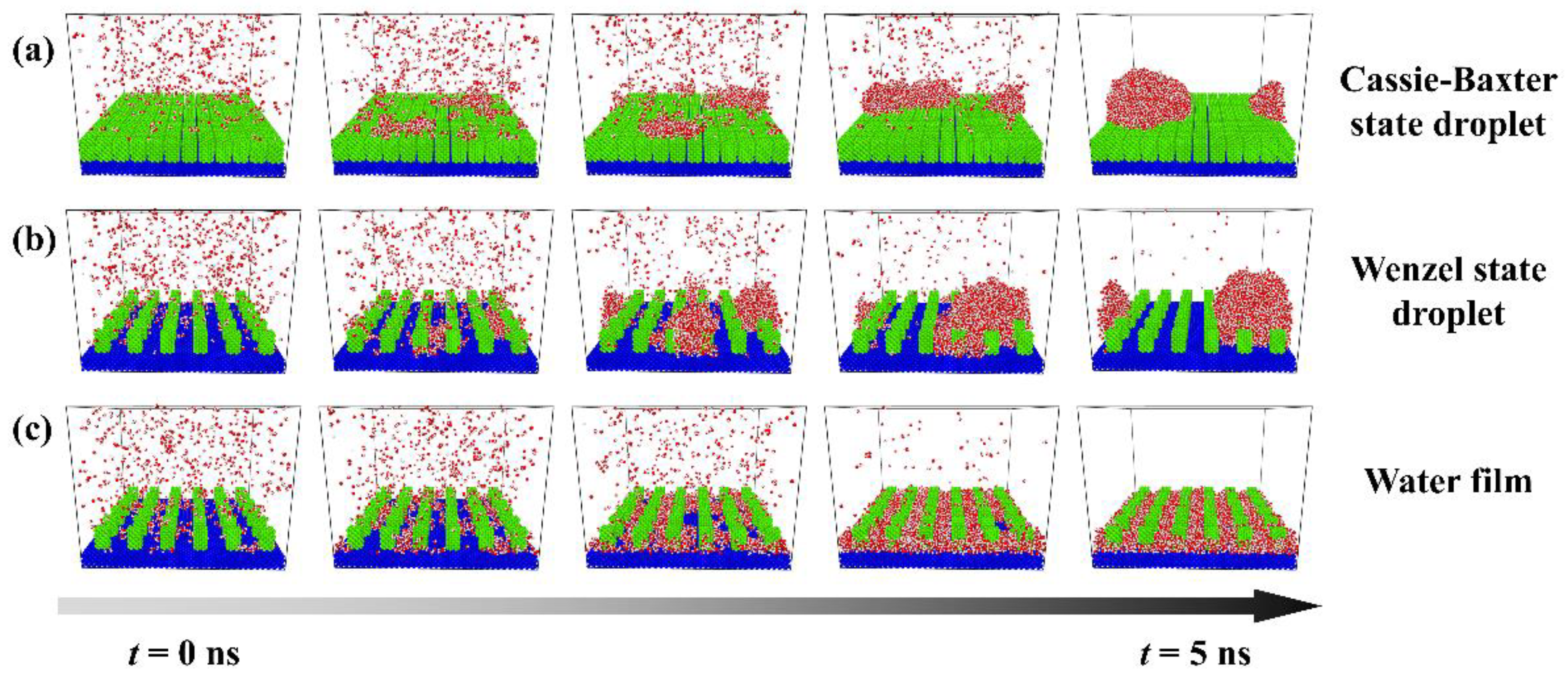
 ” represents newly formed water clusters; “
” represents newly formed water clusters; “ ” represents pre-existing water clusters).
” represents pre-existing water clusters).
 ” represents newly formed water clusters; “
” represents newly formed water clusters; “ ” represents pre-existing water clusters).
” represents pre-existing water clusters).
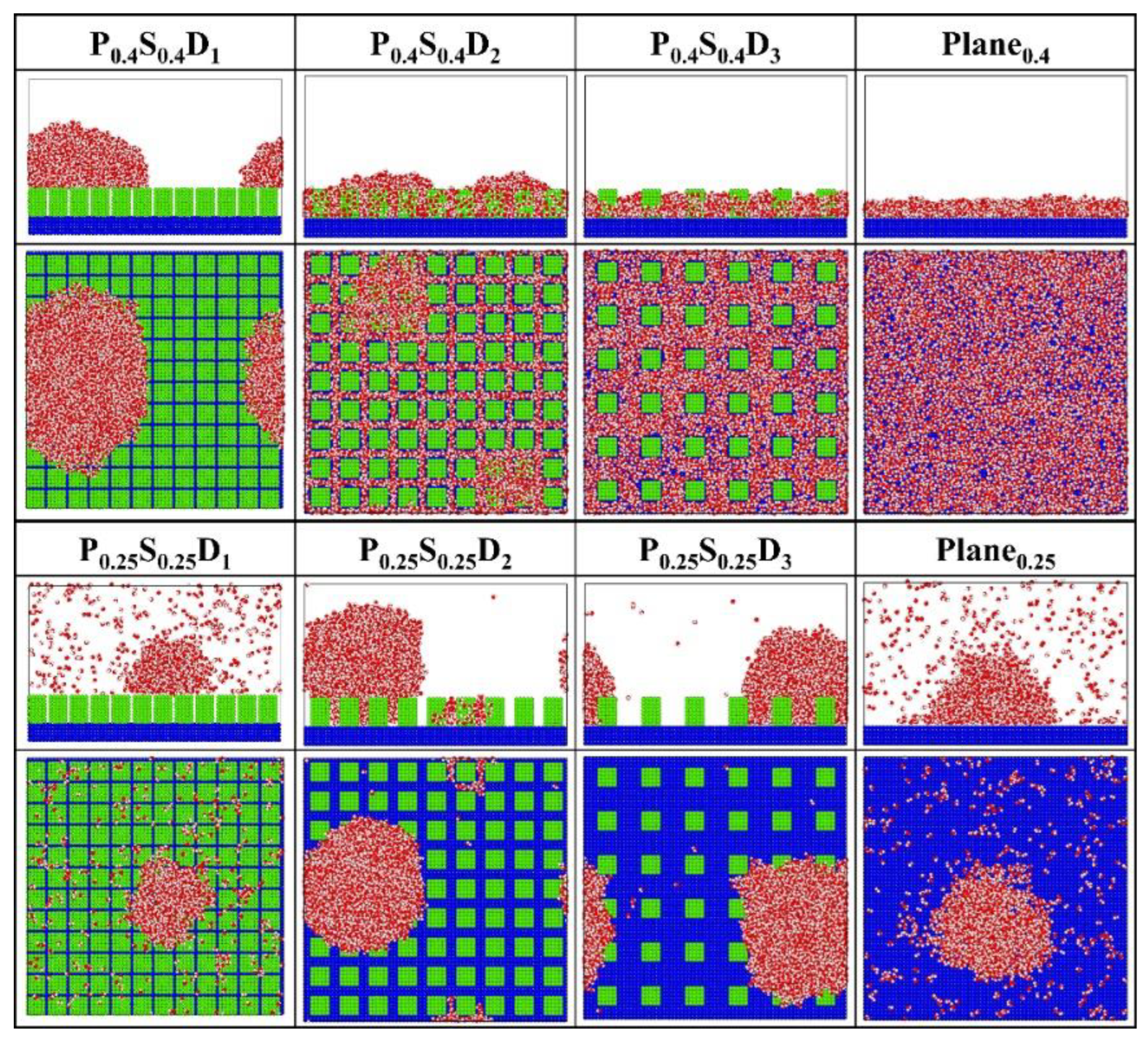
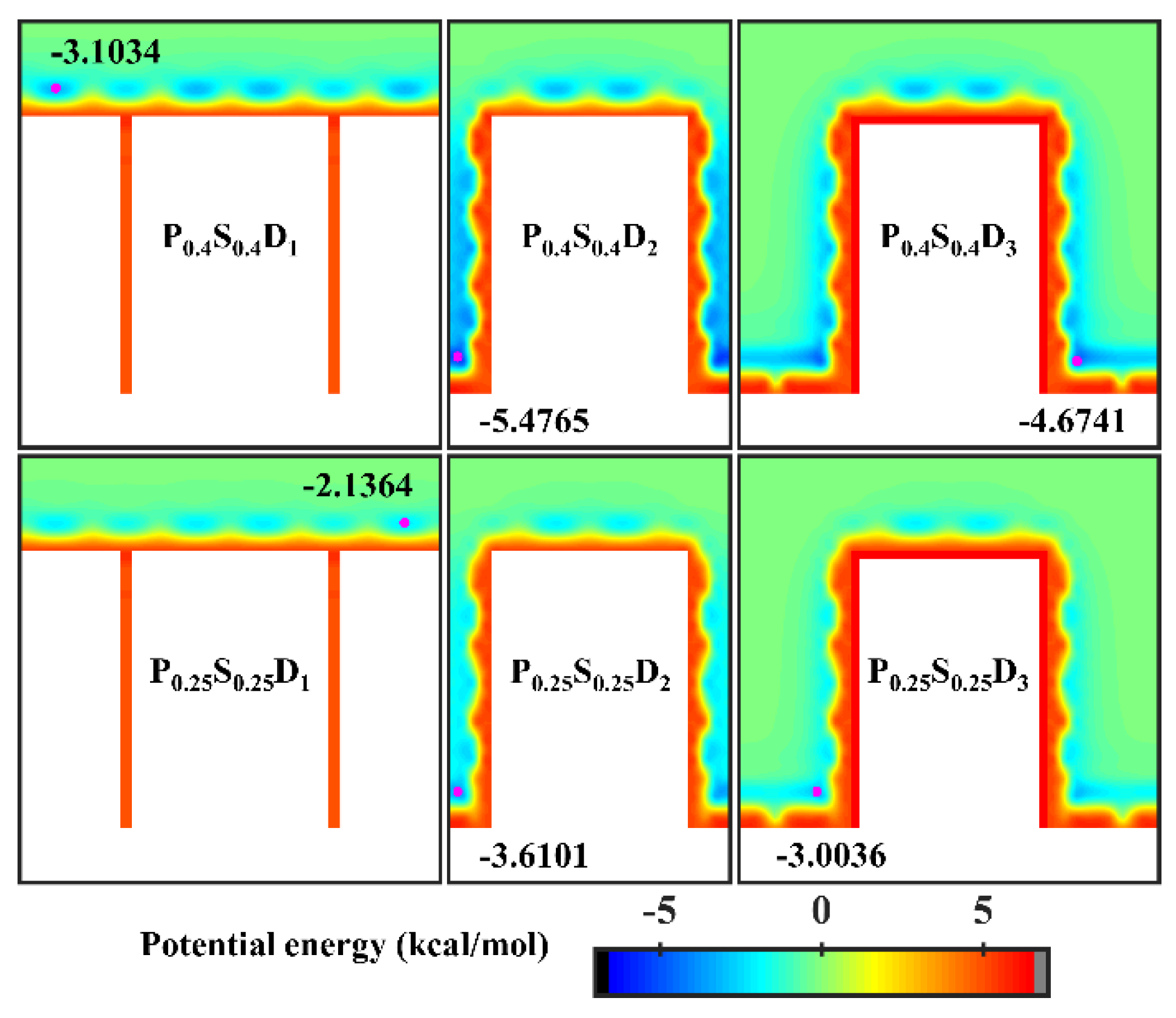
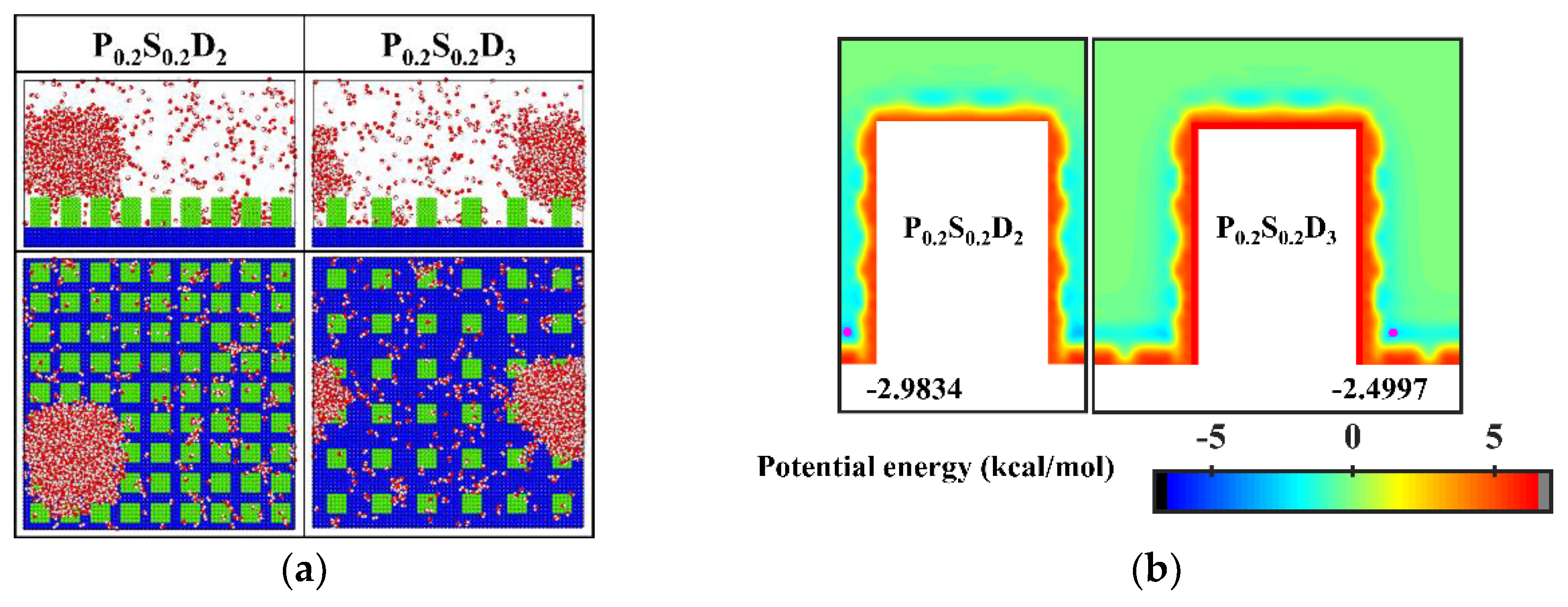

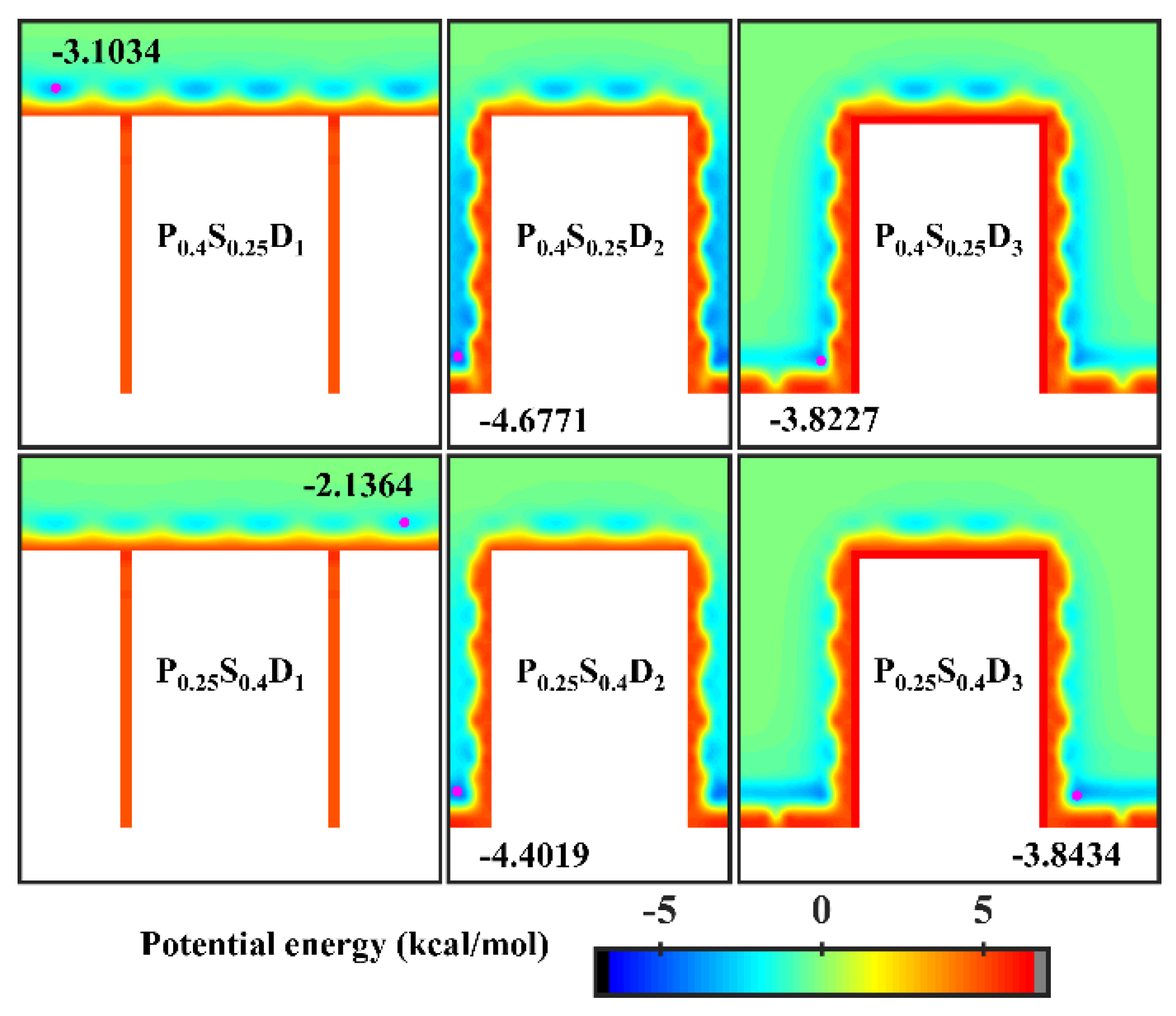
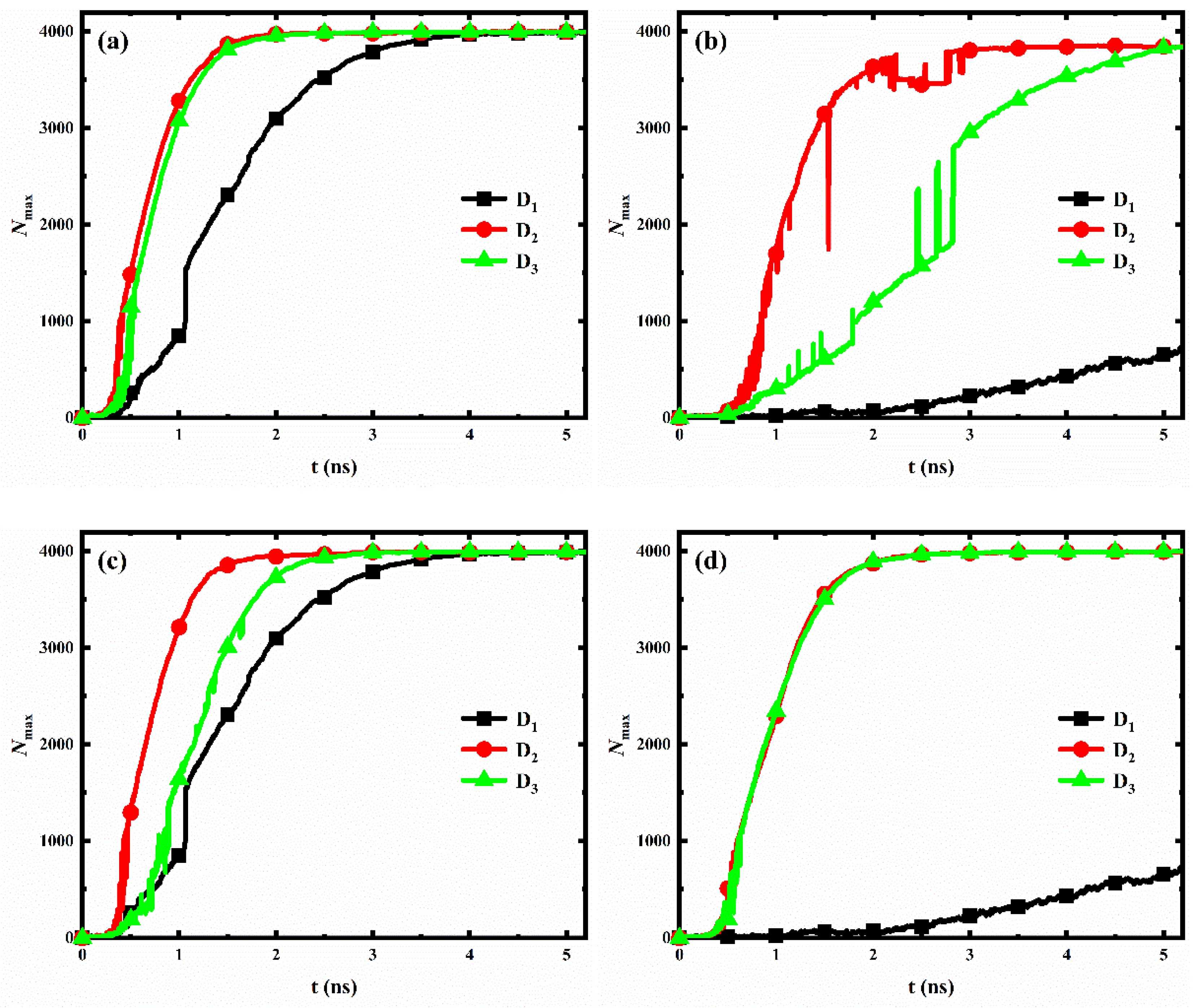
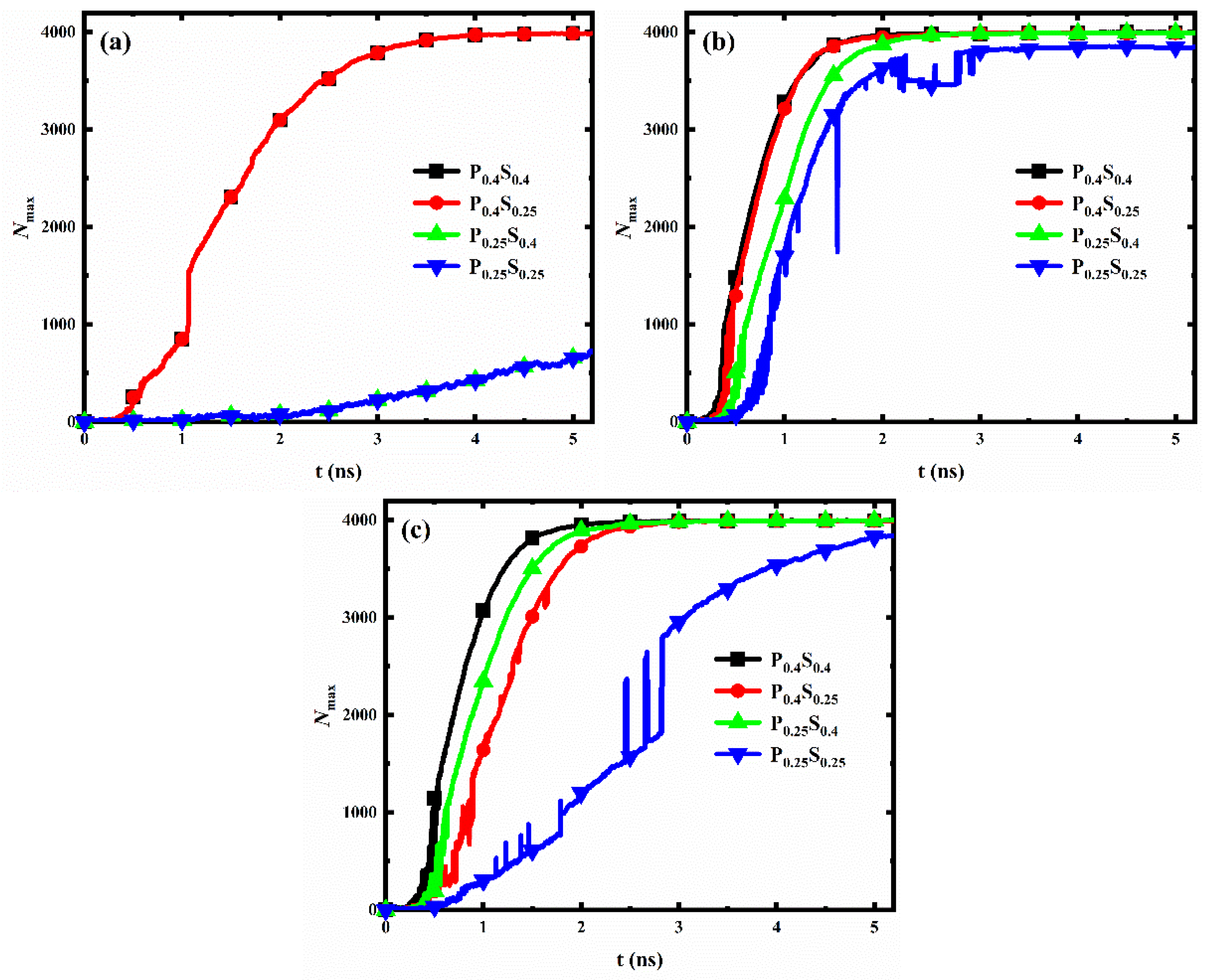


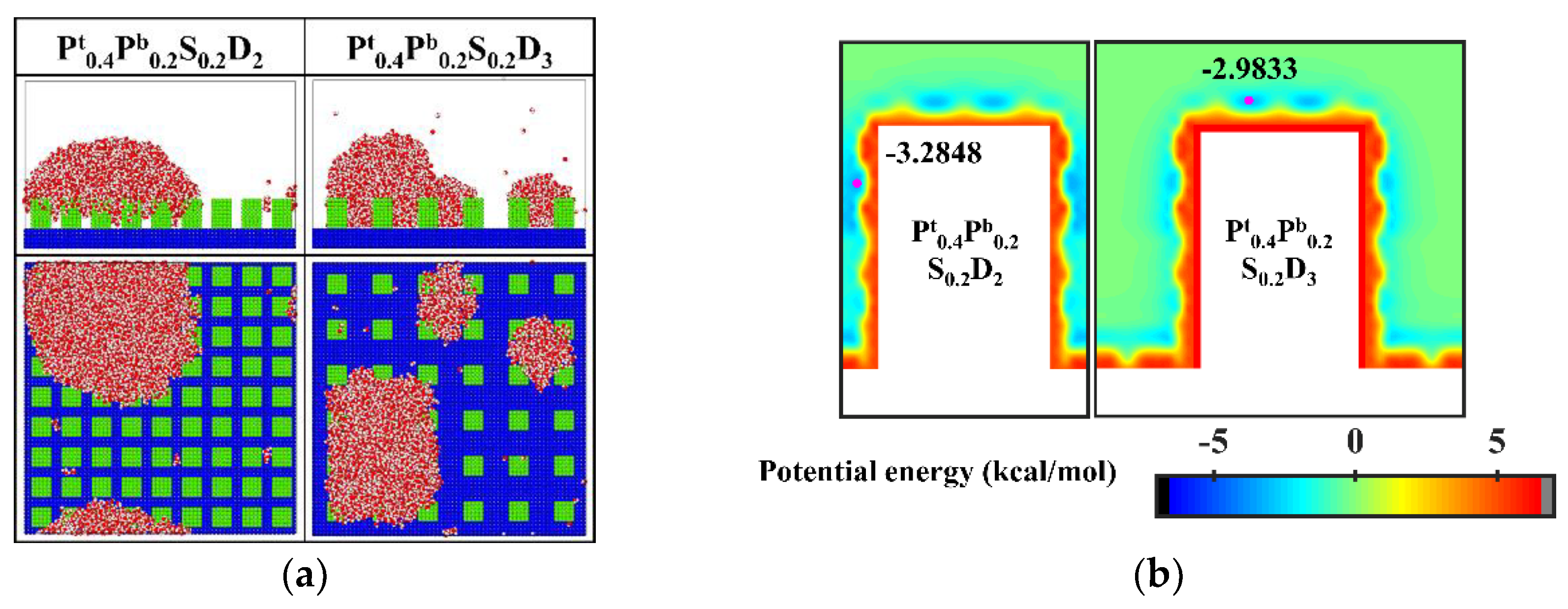
| Subscript | Nanopillar Wettability (P) | Substrate Wettability (S) | Interpillar Spacing (D) |
|---|---|---|---|
| 0.25 | 98° | 98° | / |
| 0.4 | 38° | 38° | / |
| 1 | / | / | 3.615 Å |
| 2 | / | / | 7.23 Å |
| 3 | / | / | 14.46 Å |
| Interpillar Spacing (D) | Surface Solid Fraction (ϕ) | Effective Contact Area Fraction (η) | Surface Roughness * (r) |
|---|---|---|---|
| 3.615 Å | 0.444 | 0.098 | 4.556 |
| 7.23 Å | 0.250 | 0.750 | 3.000 |
| 14.46 Å | 0.111 | 0.529 | 1.889 |
Disclaimer/Publisher’s Note: The statements, opinions and data contained in all publications are solely those of the individual author(s) and contributor(s) and not of MDPI and/or the editor(s). MDPI and/or the editor(s) disclaim responsibility for any injury to people or property resulting from any ideas, methods, instructions or products referred to in the content. |
© 2022 by the authors. Licensee MDPI, Basel, Switzerland. This article is an open access article distributed under the terms and conditions of the Creative Commons Attribution (CC BY) license (https://creativecommons.org/licenses/by/4.0/).
Share and Cite
Che, Q.; Wang, F.; Zhao, X. Design of Nanostructured Surfaces for Efficient Condensation by Controlling Condensation Modes. Micromachines 2023, 14, 50. https://doi.org/10.3390/mi14010050
Che Q, Wang F, Zhao X. Design of Nanostructured Surfaces for Efficient Condensation by Controlling Condensation Modes. Micromachines. 2023; 14(1):50. https://doi.org/10.3390/mi14010050
Chicago/Turabian StyleChe, Qi, Fenghui Wang, and Xiang Zhao. 2023. "Design of Nanostructured Surfaces for Efficient Condensation by Controlling Condensation Modes" Micromachines 14, no. 1: 50. https://doi.org/10.3390/mi14010050
APA StyleChe, Q., Wang, F., & Zhao, X. (2023). Design of Nanostructured Surfaces for Efficient Condensation by Controlling Condensation Modes. Micromachines, 14(1), 50. https://doi.org/10.3390/mi14010050



